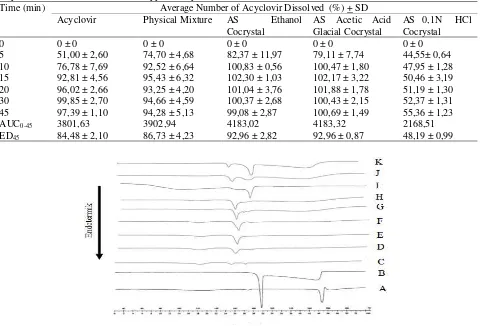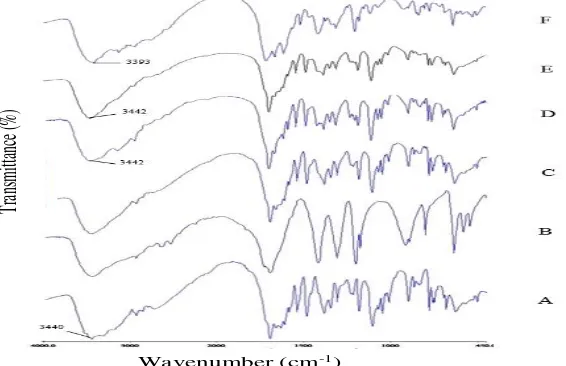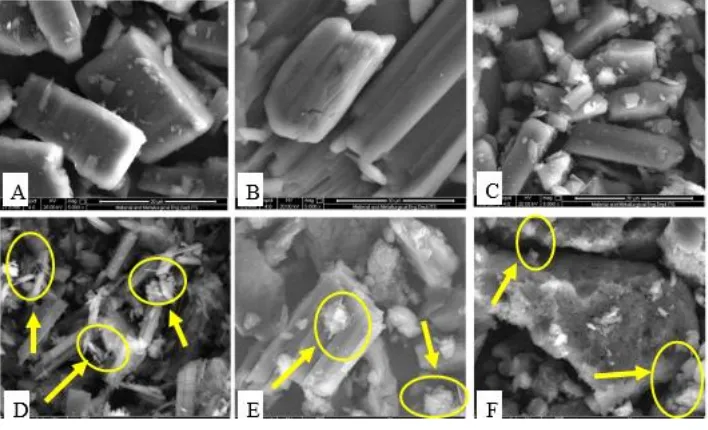ISSN: 0975 4415
Research Article
Improvement of Dissolution Properties Through Acyclovir - Succinic
Acid Cocrystal Using Solvent Evaporation Technique
Hilya Nur Imtihani
1, Agnes Nuniek W
2, Dwi Setyawan
1, Esti Hendradi
11Departement of Pharmaceutics, Airlangga University, Surabaya, East Java, Indonesia, 2Departement of Pharmaceutics, Surabaya University, Surabaya, East Java, Indonesia.
Received: 19th Oct, 17; Revised 8th Nov, 17, Accepted: 14th Nov, 17; Available Online: 25th Dec, 2017
ABSTRACT
The objective of this research was to prepared acyclovir cocrystals with succinic acid as coformer using three different solvents (ethanol, acetic acid glacial, and 0.1N HCl) to influence the characters and improve the dissolution rate of acyclovir. Cocrystallization of acyclovir with succinic acid as coformer was successfully prepared by solvent evaporation technique using three different solvents (ethanol, acetic acid glacial, and 0.1N HCl). The screening indicated that acyclovir formed novel cocrystals with succinic acid in the three different solvents. PXRD profile show that there is three peaks in
ethanol cocrystal in angle 2θ 5.9134o; 9.1645o and 13.4044o. For acetic acid glacial and 0.1N HCl cocrystal there is one
peak in angle 2θ 5.9263o and 2θ 9.6011o. In analysis diffractogram DSC formed ethanol cocrystal with melting point
175.84oC. The melting point of acetic acid glacial cocrystal is 178.41oC and 0.1N HCl cocrystal is 156.75oC. The
dissolution rate of the cocrystals measured by the effisiency disolution (ED45) that considerable faster than that pure
acyclovir and the physical mixtures. On the result of FTIR analysis there is changes of the wavenumber that indicated that there is cocrystal formed. And for SEM analysis, morphology of cocrystals was different than the original materials. In dissolution test, ethanol and acetic acid glacial cocrystals have better efficiency dissolution (ED45) (92.96 %) than the
acyclovir ED45 (84.48 %). But 0.1N HCl cocrystal has lower ED45 than acyclovir that is 48.19 %. The results obtained in
this research indicated the acyclovir cocrystals have formed with succinic acid as coformer using three different solvents. The physical properties was different from the three cocrystals. Dissolution rate of acyclovir cocrystals using ethanol and acetic acid glacial solvents was increase, whereas using 0.1N HCl was decrease rather than pure acyclovir.
Keywords: Cocystallization, acyclovir, succinic acid, solvent evaporation, dissolution rate.
INTRODUCTION
Acyclovir is of important antiviral utilized for herpes simplex and varicellar remediation due to its high selectivity and low cytotoxicity.1 However, the main
drawback of using acyclovir stems from its physical properties, i.e. low solubility in water and low permeability. Hence, it is classified into class IV according Biopharmaceutics Classification System (BCS)2.
Solubility of acyclovir in water has been found 1.62 mg· ml-1. Since its solubility is lower than 5 mg· ml-1,it
could affect the bioavailability3, which is spanning 15 –
20% with a half time of 3h1.
On account of improving solubility properties and bioavailability of drugs, cocrystallization technique has been intensively proposed4. In principle, cocrystallization
is an interaction between the drug and the conformer excipient. This crystallization technique enable modification of physicochemical properties of active pharmaceutical ingredients (API) toward a stable intrinsic molecular activities of the drug5.
In this study, made an acyclovir cocrystal with succinic acid coformer, cause succinic acid is coformer for forming cocrystal with GRAS (Generally Recognized As Safe) status6. Succinic acid as coformer cocrystal has been
investigated through the establishment of fluoxetine HCl-succinic acid cocrystal. The cocrystal showed increased solubility two times greater than the active ingredient normally7. Solvents that used in this study are three kinds,
that is ethanol, 0.1N HCl and acetic acid glacial.
Cocrystal component characterization techniques used was by Powder X-Ray Diffraction (PXRD) to determine it has produced cocrystal. Other characterization techniques are Differential Scanning Calorimetry (DSC), Fourier Transform Infrared Spectroscopy (FTIR) and microscopy analysis by Scanning Electron Microscopy (SEM)8. In
addition to the characterization tests, dissolution test is also conducted in the media of pH 6.8 phosphate buffer maintained constant media temperature 37 ± 0.5 ° C.
MATERIALS AND METHODS Materials
Acyclovir, Sigma-Aldrich®, pro analysis (Cina); Succinic
acid, Emsure®, pro analysis (Merck KGaA, Jerman);
aquadest (PT. Widatra Bhakti); Ethanol, Emsure®, pro
analysis (Merck KGaA, Jerman); HCl, Smart-Lab®, pro
analysis (PT. Smart Lab Indonesia); Acetic acid glacial, Mallinckrodt AR®, pro analysis (Perancis) and phosphate
Formation of Binary Systems Phase Diagram
Acyclovir and succinic acid sifted to have a particle size range equal then weighed and prepared physical mixture with a ratio w/w (1:9), (2:8), (3:7), (4:6), (5:5), (6:4), (7:3), (8:2), (9:1). The melting point of the physical mixture of
acyclovir-succinic acid was determined by DSC thermal analysis.
Cocrystallization Process Prepared with Solvent Evaporation Method.
22.52 mg acyclovir and 11.81 mg succinic acid (ratio 1 : 1 Table 1: Percent of Dissolved Acyclovir, AUC0-45 of Dissolved Acyclovir and ED45 on Acyclovir, Physical Mixture of
Acyclovir-Succinic Acid and Three Types Cocrystal.
Time (min) Average Number of Acyclovir Dissolved (%) + SD Acyclovir Physical Mixture AS Ethanol
Cocrystal
AS Acetic Acid Glacial Cocrystal
AS 0,1N HCl Cocrystal
0 0 ± 0 0 ± 0 0 ± 0 0 ± 0 0 ± 0
5 51,00 ± 2,60 74,70 ± 4,68 82,37 ± 11,97 79,11 ± 7,74 44,55± 0,64 10 76,78 ± 7,69 92,52 ± 6,64 100,83 ± 0,56 100,47 ± 1,80 47,95 ± 1,28 15 92,81 ± 4,56 95,43 ± 6,32 102,30 ± 1,03 102,17 ± 3,22 50,46 ± 3,19 20 96,02 ± 2,66 93,25 ± 4,20 101,04 ± 3,76 101,88 ± 1,78 51,19 ± 1,30 30 99,85 ± 2,70 94,66 ± 4,59 100,37 ± 2,68 100,43 ± 2,15 52,37 ± 1,31 45 97,39 ± 1,10 94,28 ± 5,13 99,08 ± 2,87 100,69 ± 1,49 55,36 ± 1,23 AUC0-45 3801,63 3902,94 4183,02 4183,32 2168,51
ED45 84,48 ± 2,10 86,73 ± 4,23 92,96 ± 2,82 92,96 ± 0,87 48,19 ± 0,99
Figure 1:DSC Thermogram of Acyclovir (A), Acid Succinate (B) and Physical Mixtures with multiple rasio (w/w), 9:1 (C), 8:2 (D), 7:3 (E), 6:4 (F ), 5:5 (G), 4:6 (H), 3:7 (I), 2:8 (J) and 1:9 (K).
Figure 2:Phase diagrams of binary systems acyclovir-succinic acid with different molar fraction ratio.
Temperature (°C)
Acyclovir-Succinic Acid Molar Fraction Ratio
T
em
per
atu
re
(°C
5 10 15 20 25 30 35 40
(F)
(E)
(D)
(C)
(B)
‡
*
* *
2 / degree
* †
(A)
Figure 3:Comparison Diffractogram of acyclovir (A), succinic acid (B), physical mixture of acyclovir-succinic acid (C) and three types of cocrystal with ethanol (D), acetic acid glacial (E) and 0.1N HCl (F) solvent. (*) indicates
characteristic crystal diffraction peaks of ethanol cocrystal at an angle 2θ (theta) 5,9134o; 9,1645o dan 13,4044o. (†)
indicates characteristic crystal diffraction peaks of acetic acid glacial cocrystal at an angle 2θ (theta) 5,9263o. (‡)
indicates characteristic crystal diffraction peaks of 0.1N HCl cocrystal at an angle 2θ (theta) 9,6011o.
Figure 4:DSC thermogram comparison of acyclovir (A), succinic acid (B), physical mixture of acyclovir-succinic acid (1: 1) (C), and three cocrystal with ethanol (D), glacial acetic acid (E) and HCl 0.1 N (F) solvents.
Figure 5:Infrared spectrum of acyclovir (A), succinic acid (B), physical mixture of acyclovir-succinic acid (C) and three types of cocrystal with ethanol (D), acetic acid glacial (E) and 0.1N HCl (F) solvent.
Temperature (°C)
Endote
rm
ic
Tran
sm
ittan
ce
(%
)
solutions were mixed and stirred using a stirrer until all the solvent evaporates. The solution was evaporated at room temperature for 48 hours or until a cocrystal formed. Cocrystals obtained is stored in a desiccator.
Crystals Lattice (PXRD)
Crystal lattice analyzed by PXRD (X'Pert PRO, PANalytical) with the following conditions: target / filter (monochromator) Cu, voltage 40kV, 30mA current, slit width of 0.2 inches. Data were collected with a scanning mode 0,2o-0,5o per minute with a scanning distance 2q =
5o- 40o.
Melting Point (DSC)
Thermal analysis of samples done by using a DSC Mettler Toledo. A sample of about 5 mg is placed on an aluminum pan is covered. DSC tool programmed over a temperature range of 30 to 300°C with a heating rate of 5°C per minute.
Hydrogen Bond (FTIR)
Samples in powder form mixed with KBr crystals in the ratio sample:KBr (1:100) and ground until homogeneous then compressed at 20 Psi using a KBr plate felts. The spectra were measured using FTIR spectroscopy Jasco - 4200. Then the disc is placed in the sample holder is then recorded. Samples were observed in the absorption band or wavenumber 4000 - 450 cm-1.
Crystals Morphology (SEM)
Sample powder is placed on the sample holder aluminum and coated with gold to a thickness of 10 nm. Samples were observed on a variety of SEM magnification tool with a working voltage is set 20 kV and 12 mA current. Measurements were made in 2500x and 5000x magnification.
Dissolution Test
The dissolution test performed in phosphate buffer pH 6.8 media with paddle method rotated at 50 rpm and media temperature kept to 37 ± 0.5°C. 100 mg of material was weighed and put in a dissolution vessel with 900 mL of phosphate buffer. Dissolved substance is determined every 5, 10, 15, 20, 30 and 45 minutes by sampling dissolved respectively of 5 mL and then filtered with filter paper size
of 0.45 μm and was soon replaced with a volume and shape
similar media.
RESULT AND DISCUSSION
Examination Phase Binary System with DSC
Establishment of the binary system phase diagram of acyclovir and succinic acid components by analyzing using thermal analysis DSC from acyclovir, succinic acid and physical mixture of both components with a ratio w/w, (9:1), (8:2), (7:3), (6:4), (5:5), (4:6), (3:7), (2:8), (1:9). DSC thermogram analysis results shown in Figure 1. Results from binary phase diagram shows that the molar ratio of the acyclovir-succinic acid (1:1) can be generated cocrystal with the melting point of about 168,62-173,58oC
(Figure 2). Furthermore, the manufacturing process acyclovir cocrystal with succinic acid coformer in this study will be conducted at a molar ratio of 1:1.
Crystal Lattice Analysis With PXRD
Cocrystal first evaluation conducted in this study is the characterization tests for cocrystal component include Powder X-Ray Diffraction (PXRD) tests to determine it
has produced cocrystal. In figure 3, the PXRD diffractogram illustrates characteristic diffraction peaks of the formation of three types of cocrystal compared with pure acyclovir, pure succinic acid and physical mixtures. In cocrystal with ethanol to form three new peak with great intensity and seen that the angle 2θ 5.9134o (int = 79.35%);
9.1645o (int = 16.81%) and 13.4044o (int = 13.99%).
Whereas for cocrystal with acetic acid glacial solvent to
form a new peak at an angle 2θ 5.9263o (int = 10:18%) and
to cocrystal with 0.1N HCl solvent to form a new peak with
the angle 2θ 9.6011o (int = 28.26%).
DSC Thermal Analysis
Thermal analysis did by DSC related to influence the formation of cocrystal to the melting point of a substance. DSC analysis results in Figure 4, stating that the melting point of the formation of cocrystal acyclovir-succinic acid with ethanol is at a temperature 175.84oC (ΔH = -1.86 Jg -1). Then melting point of the acetic acid glacial cocrystal is
178.41oC (ΔH = -0.14 Jg-1), whereas with 0.1 N HCl
solvent has a melting point of 156.75°C (ΔH = -23.53 Jg -1). The cocrystal melting point is below the melting point
of acyclovir (253.53°C) and succinic acid (187.29°C). It states that the new crystals had formed with different melting point value of the constituent materials.
FTIR Spectrum Analysis
In the FTIR spectrum, acyclovir-succinic acid cocrystal indicated a characteristics peak shift of the materials used. This analysis is done by an infrared spectrophotometer at the wavenumber range 4000-450 cm-1 which are illustrated
in Figure 5. The shift of functional groups wavenumber value on the infrared spectra showed the formation of interaction the drug with coformer to form cocrystal4. In
this study, it can be shown eg group N-H amide / amine on aciclovir had a wavenumber of 3440 cm-1 but at cocrystal
with ethanol and acetic acid glacial to shift more into 3442 cm-1. Similarly with other functional groups which nearly
all shifted when compared to the acyclovir.
Increased of wavenumber in N-H group of acyclovir into acyclovir-succinic acid cocrystal with ethanol and acetic acid glacial stated that the primary amine group of acyclovir weak hydrogen bonds with succinic acid4.
Microphoto SEM Analysis
Based on the results of the SEM photomicrograph indicated that there is a change of any material and solids that formed. Significant changes observed in the form of cocrystal with ethanol. In the figure 6.A / 7.A shows the appearance of acyclovir powder with a beam shape and size are irregular. Particle beam acyclovir as covered by submicron particles smaller. Succinic acid coformer looks like aggregate beam fractions greater than acyclovir and finer (figure 6.b / 7.b).
Dissolution Test Profil
Figure 6: SEM of acyclovir (A), succinic acid (B), physical mixture of acyclovir-succinic acid (C) and three types of cocrystal with ethanol (D), glacial acetic acid (E) and 0.1N HCl (F) solvent with magnification 2500x.
Figure 7: SEM of acyclovir (A), succinic acid (B), physical mixture of acyclovir-succinic acid (C) and three types of cocrystal with ethanol (D), glacial acetic acid (E) and 0.1N HCl (F) solvent with magnification 5000x.
Figure 8: Dissolution Profile of acyclovir, succinic acid, a physical mixture of acyclovir-succinic acid and three kinds kokristal with ethanol, acetic acid glacial and 0.1N HCl.
Acyclovir
Physical Mixture
Ethanol Cocrystal
Acetic Acid Glacial Cocrystal
acyclovir-succinic acid stood at 92.52% concentration dissolved.
From the dissolution test data obtained then calculated the efficiency of dissolution (ED45) to be statistically analyzed
using ANOVA oneway. The result of the calculation of the efficiency of dissolution cocrystal with ethanol and acetic acid glacial has the same values, respectively, are 92.96% ± 2.82 and 92.96% ± 0.87 and this value is greater than acyclovir pure and physical mixture in succession ie 84.48% ± 2.10 and 86.73% ± 4.23. While cocrystal with 0.1N HCl solvent has a efficiency of dissolution value is 48.19% ± 0.99 under pure and acyclovir physical mixture (Table 1).
Statistical Analysis of Dissolution Test
Statistical analysis of dissolution test (ED45) of pure
acyclovir, physical mixture of acyclovir-succinic acid and three kinds cocrystal of ethanol, acetic acid glacial and 0,1N HCl conducted on the degree of confidence of 0.95
(α = 0.05) showed a significant influence on differences in
the efficiency dissolution (ED45) of the fifth samples with
value sig. obtained was 0.000 < 0.05. This means that the manufacture cocrystal acyclovir-succinic acid by solvent evaporation method is effective in increasing the dissolution rate of the pure acyclovir.
CONCLUSION
Based on the results of this research note that acyclovir with coformer succinic acid using solvent evaporation method from three kinds of solvents, namely ethanol, acetic acid glacial and 0.1 N HCl is capable of forming cocrystal with the characteristics and dissolution rate are different. Overall manufacture cocrystal with ethanol has a characterization results that support the results of dissolution increased from PXRD, DSC, FTIR and SEM. Similarly, the acetic acid glacial solvent cocrystal that the characterization results in line with the increasing rate of dissolution of acyclovir dissolved. Whereas for the evaporation of the solvent with 0.1N HCl decide that the characterization is not supported by the results of dissolution test. This can be due to the formation of a new crystal lattice of cocrystal 0.1N HCl has characteristics that decrease the rate of dissolution. The process of dissolution test cocrystal acyclovir-succinic acid was conducted for 45 minutes. In terms of security, then cocrystal with ethanol
and acetic acid glacial is the most secure because they are classified in class 3 solvents that have a low toxicity effect9. In terms of yield cocrystal, then ethanol cocrystal
has the greatest yield in accordance with the maximum intensity of diffraction peaks which can be given.
REFERENCES
1. Bruni G, Maietta M, Maggi L, Mustarelli, Ferrara C, Berbenni V, Milanese C, Girella A, Marini, A. Preparation and Physicochemical Characterization of Acyclovir Cocrystals with Improved Dissolution Properties. Journal of Pharmaceutical Sciences 2013. 2. Sarkar A, Rohani S. Cocrystals of Acyclovir with
Promising Physicochemical Properties. Journal of Pharmaceutical Sciences2015; 104: 98-105.
3. Shargel L, Wu-Pong S, Yu ABC. Applied Biopharmaceutic and Pharmacocinetic. Translate by Fasich and Budi Suprapti. 5, Airlangga University, Surabaya, 2012, 414-417, 456-465.
4. Masuda T, Yoshihashi Y, Yonemochi E, Fujii K, Uekusa H, Terada K. Cocrystallization and Amorphization Induced by Drug-Excipient Interaction Improves the Physical Properties of Acyclovir. International Journal of Pharmaceutics 2012; 422: 160-169.
5. Allam AN, Naggar VF, El Gamal SS. Formulation and Physicochemical Characterization of Chitosan/Acyclovir Co-crystals. Pharmaceutical Development and Technology 2013; 18(4): 856-865. 6. Wouters J, Rome S, Quere L.. Monographs of Most
Frequent Co-crystal Formers. In:Wouters, J., Quere, L (Eds). Pharmaceutical Salts and Cocrystals. Cambridge : The Royal Society of Chemistry, 2012, 338-82. 7. Najar AA dan Azim Y. Pharmaceutical Co-Crystals : A
New Paradigm of Crystal Engineering. Journal of Indian Institute of Science 2014; 94(1): 45-67. 8. Schultheiss N, Henck JA. Role of Co-crystals in the
Pharmaceutical Development Continuum. In:Wouters, J., Quere, L (Eds). Pharmaceutical Salts and Co-crystals. Cambridge : The Royal Society of Chemistry 2012; 110-127.


